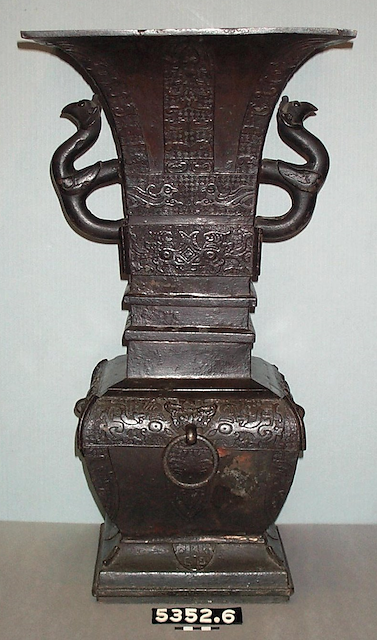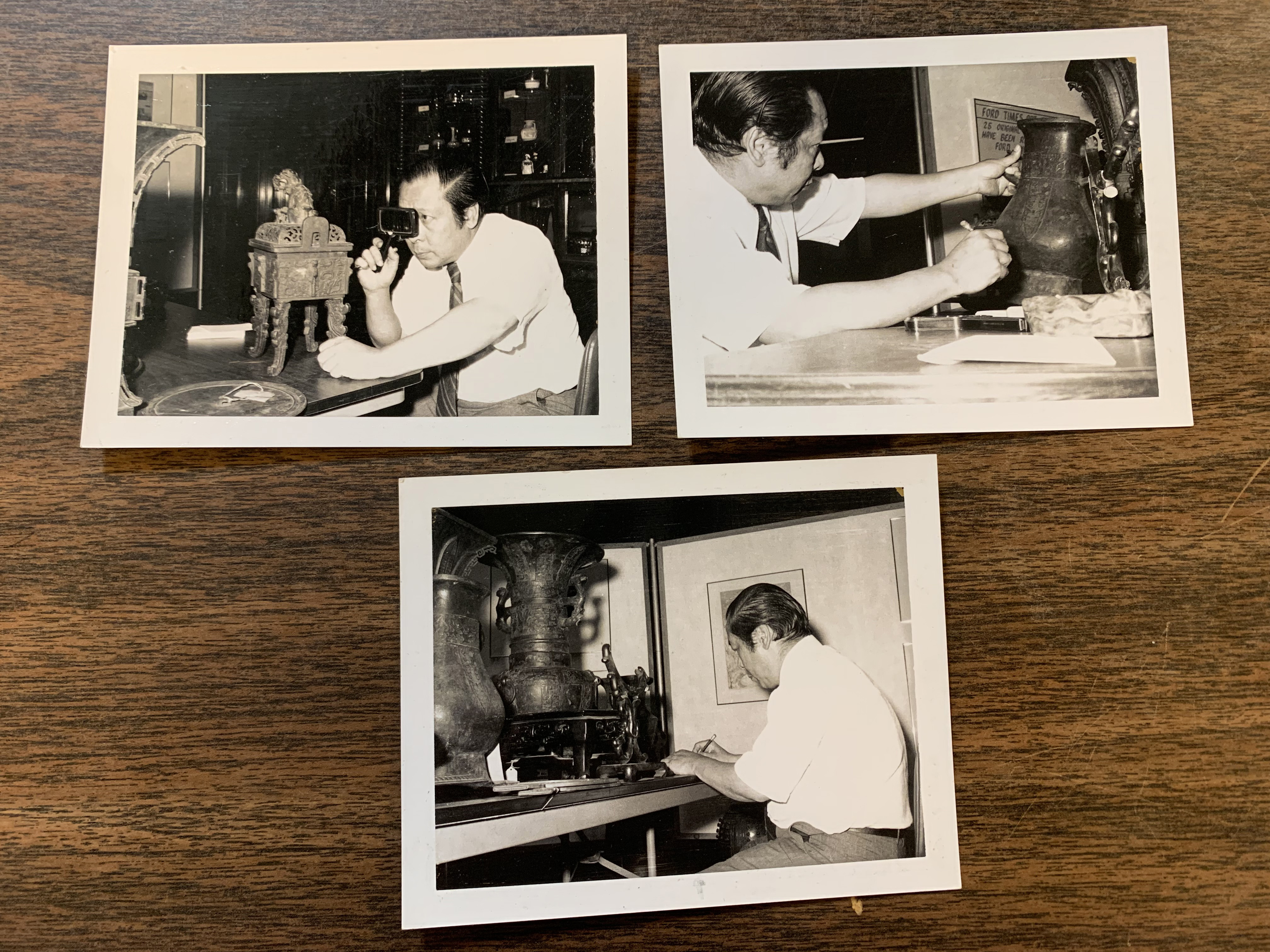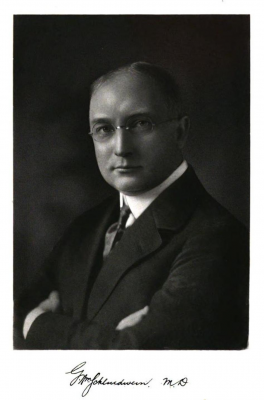Rediscovering Dr. William Schlindwein, Erie's Long-Forgotten Art Collector
Ancient Asian bronzes unearthed from Hagen History Center archives
While interning at the Hagen History Center during the summer of 2023, I became captivated by a collection of Asian bronzes in storage at the museum, but even more so by their mysterious collector, Dr. William Schlindwein (1872-1946).
Dr. Schlindwein was Erie's first head and neck surgeon, a devout Catholic, and an affluent art collector. During his lifetime, his influence on Erie society was considerable — he even makes an appearance in historian John Elmer Reed's 1925 History of Erie County, Pennsylvania. Reed presents Schlindwein as brilliant and successful, well-connected, and well-traveled.
At some point, the doctor became interested in collecting art, particularly Asian art, an aesthetic craze that was sweeping through America. Though secretive about his finances, one of his largest acquisitions of artwork was a set of Chinese and Japanese bronzes that he donated to the Erie Public Museum (now the Hagen History Center). Six of these bronze objects — thought to be thousands of years old — will be on display in February at the HHC as part of their Lunar New Year exhibition, and are part of a long-forgotten history of art collecting in Erie.
Many of the details of Dr. Schlindwein's life remain a mystery, but I pieced together a general overview from various archival sources. He was born in Erie on Sept. 8, 1872 to parents George and Louise (Meyer) Schlindwein. George Schlindwein was an affluent merchant and owned a harness and leather shop in Erie for over 50 years. George, an Erie native, married Louise Meyer of Philadelphia, and the couple had five children, of whom G. William Schlindwein was the eldest.
According to Reed, he attended parochial schools growing up before becoming employed at the coal office (which coordinated incoming and outgoing coal distribution) of R.W. Russell and later as a bookkeeper at the Jacob Weschler Company. In 1902, he married Erie native Rose E. Conrath, his life partner, although they never had any children.
Later, he enrolled in medical school at Jefferson Medical College in Philadelphia, graduating in 1904. He spent 1904 and 1905 working as an intern and a resident in Philadelphia before moving back to Erie in 1906. Upon his return, he was appointed chief of surgery at Hamot. He then moved abroad to complete post-graduate work in Berlin and Vienna in 1912. According to one obituary, this move was in pursuit of his medical specialty — ophthalmology. He reportedly returned after studying at the leading clinics in Europe, becoming Erie's first head and neck surgeon and establishing his permanent practice at 138 W. Ninth St.
It is impossible to know when Schlindwein developed an interest in collecting art, particularly Asian art. It is likely that he encountered American collections of Asian art in Philadelphia, perhaps at the Free Museum of Science and Art at the University of Pennsylvania, which was newly opened in 1899. Additionally, he could have visited American expositions of Japanese arts and industry, which were incredibly popular during the Meiji period (1868-1912). Regardless of when or where Schlindwein began collecting art, his interest in Asian artwork fits among a larger trend of American collecting, both for private and public display.
 This bronze sculpture is in the collection of Schlindwein bronzes currently stored at the Hagen History Center. Discovered and researched by summer intern Aurelia Goodall at the center, the pieces will soon be on public display.
This bronze sculpture is in the collection of Schlindwein bronzes currently stored at the Hagen History Center. Discovered and researched by summer intern Aurelia Goodall at the center, the pieces will soon be on public display.
(Early Qing dynasty bronze vase, Source: Hagen History Center)
Between the end of the 19th century and the middle of the 20th, America would see the founding of the Freer Gallery of Art in Washington, D.C., the development of Asian departmental collections in the Cleveland Museum of Art and the Nelson-Atkins Museum of Art, as well as the growth of private collections by industrial powerhouses J. P. Morgan and John D. Rockefeller. Schlindwein, although little-known, is an important piece of the story of Asian art collecting in the United States, particularly because of his convenient location in Erie — at the time, an industrial powerhouse connected to key cities such as Detroit, Cleveland, Pittsburgh, and New York by rail, cultivating the growth of Schlindwein's medical practice and his art collecting.
Beyond medicine and the arts, the most important aspect of Schlindwein's life seems to have been his Catholic faith. In one obituary, the first sentence describes Schlindwein as "prominent Erie specialist and Catholic layman" — two elements that encapsulated his identity. His Catholic faith not only inspired his donations of artwork later in his life to Archbishop John Mark Gannon, Cathedral Prep, and St. Joseph's Home for Children, but may have also affected his collecting habits. For wealthy men such as Schlindwein, collecting Asian art was a way to forge a new elite and cosmopolitan identity, while Christian missionary work made their collecting habits possible.
Missionaries were in fact central to the physical acquisition of Chinese and Japanese artworks in the late 20th and early 21st centuries, such as in the case of native Detroit collector Charles Lang Freer. For Dr. Schlindwein, missionary art dealing and collecting was essential to his single most significant acquisition.
Between June and December of 1938, Schlindwein communicated with both Muriel S. Weber and M. L. Ulmer of Pittsburgh, who appear to have worked for The Welders Service Company or The S. Ulmer and Sons Company, based upon the letterheads of correspondence. These two individuals had somehow come into possession of a collection of Chinese and Japanese bronzes, which Dr. Schlindwein was very interested in purchasing.
At first, Schlindwein seemed uninterested in where the bronzes came from or how they arrived in America, requesting information about the objects and then employing a Mr. Harvey Emerman of Erie to appraise the collection. He purchased the set of 60 bronzes from Weber and Ulmer at the beginning of 1939 for $1,000 — despite Emerman's appraisal coming in just short of $9,000 (about $22,000 and $200,000 in today's dollars, respectively). It was a very good deal.
However, the delivery of the bronzes did not proceed smoothly, with a series of letters from Weber to Schlindwein apologizing for the collection arriving with missing and broken pieces. Weber ultimately located three missing mirrors and had them shipped to Schlindwein, along with promises of "several extra vases" which he sincerely wished for Schlindwein to keep.
It was only a few days later that Dr. Schlindwein apparently inquired where the bronzes originated, based upon the response from Weber. After yet another apology for the loss of the bronze mirrors, Weber writes, "There isn't much I can tell you about the history of the bronzes, I'm sorry to say. They were collected by a Miss Jane Adams who was a missionary to China. [She] bought and sold them to maintain the mission, and the collection you now have was purchased for herself, and [was] in Carnegie Library in Pittsburgh for a good many years, and after her death the Union Trust Company who was the executor of the estate sold them to Mr. Ulmer and myself. They tried to find something out about them for us, but her heirs were so scattered (none in Pgh.) that it was impossible to find out anything. I do know, however, that you have a very valuable collection, and I believe you appreciate that fact."
This response from Weber, though lacking information in many aspects, offers some key takeaways in terms of Schlindwein's collection habits. It shows that Schlindwein purchased the "Jane Adams collection" without any knowledge of its provenance or history, which in turn demonstrates the complicated and often untraceable history of Asian objects collected at this time in America. We will likely never know more about the history of Schlindwein's bronzes due to this fact. I have been unable to identify the missionary Jane Adams (perhaps largely due to the commonness of her name) or her family, if she existed at all.
The fact that Schlindwein purchased these objects in bulk may reveal that his interest in Asian art may stem from an abstract expectation of both quality and quantity, rather than a personal aesthetic preference. The number of bronzes seemingly guarantees that at least some, if not most, of the objects will be deemed "valuable" or "beautiful" by Schlindwein, a theory that is enforced by the fact that I do not believe Schlindwein ever saw the bronzes prior to purchasing them, but only had them described to him over the phone and through letters.
Finally, there is the ambiguity of intention for these objects — did Schlindwein want to keep the bronzes, or did he want to donate them?
His decision was made a few years later by the gift of the Watson-Curtze mansion to the Erie Public Museum upon the death of Felix F. Curtze in 1941. Perhaps Dr. Schlindwein, who was a member of the museum board, was excited about the Curtze mansion as a location to exhibit his collection. The donation of the Chinese and Japanese bronzes in November of 1941 seems to have been celebrated with an opening party, as evident by a list of invitees to members of affluent Erie society. Over the next 60-plus years, Schlindwein's bronze collection at the Erie Public Museum, another collection of Asian artwork at Gannon University, and perhaps dozens of other works of art have remained hidden away in archives and basements, unseen and unstudied.
Despite the brief display of these objects at this opening event and one exhibition in the 1970s, Schlindwein's bronzes have gone largely ignored.
 Dr. Wai-Kam Ho, an expert in Asian art working at the Cleveland Art Museum in the 1970s, assessed the Schlindwein bronzes then in the possession of the Erie Public Museum, which today is the Hagen History Center. (Photos from Hagen History Center archives)
Dr. Wai-Kam Ho, an expert in Asian art working at the Cleveland Art Museum in the 1970s, assessed the Schlindwein bronzes then in the possession of the Erie Public Museum, which today is the Hagen History Center. (Photos from Hagen History Center archives)
In the winter of 1975-76, the Erie Public Museum opened a new exhibition: Oriental Bronze. The exhibition consisted almost solely of the Schlindwein bronzes, donated in 1941 and 1942, along with a few other items. According to the exhibition catalog, "The Erie Public Museum recently consulted Dr. Wai-Kam Ho of the Cleveland Art Museum Oriental Art Division, for a look at one of Erie's finest oriental bronze collections." It is unclear what or whose connections brought Dr. Wai-Kam Ho to the Erie Public Museum, but he was no amateur. Dr. Ho, one of the world's leading experts in Chinese art, was trained at Harvard and was a curator at both the Cleveland Museum of Art and the Shanghai Museum. Dr. Ho surveyed the Schlindwein collection — which had dwindled to 55 pieces at this point — and concluded that the bronzes were in "good condition" and represented "a basic introduction to the art form of oriental bronze castings." The most impressive piece, he informed the museum, was "a small bronze hand mirror, polished on one side and decorated on the other with the sacred Chinese animals of the four cardinal points," interesting considering the near-loss of the bronze mirrors during transportation.
He dated the mirror from between 100 B.C. to 100 A.D. It and other bronzes went on display alongside the catalog, which offered historical context about the bronze casting in Asia more broadly. The museum also retained a copy of information about the bronzes "as inspected by Wai-Kam Ho," which is a glowing report and contains translations of some of the inscriptions. Among the objects listed include another bronze mirror dating from the Qing dynasty used as a wedding gift, a bronze bell reportedly dating to the reign of the Qianlong emperor, and a Japanese bronze vase from the late Edo period. These identifications, if true, make for a very valuable collection from Schlindwein.
After the 1975-76 exhibition, the objects seem to have gone back into storage indefinitely. When Aurelia Goodall, another intern from the summer of 2023, researched a bronze vase from the Schlindwein collection and presented a video on Hagen History Center's social media, the collector and collection were reintroduced to the Erie public, albeit on a small scale.
This winter however, Goodall will present an exhibition including the Schlindwein bronzes at the center as part of her museum studies major at Mercyhurst University — perhaps spurring further investigation into their provenance, collecting practices of the time, and Erie's legacy therein.
The Schlindwein collection — or what remains of it at the Hagen History Center — is a remarkable example of Erie history and cultural heritage which deserves to be remembered. This is not solely because the pieces are beautiful — although they are — or because they are "authentic"— which they may or may not be.
The winding, complicated story attached to them, from the mysterious missionary Jane Adams to Dr. and Mrs. Schlindwein to the Hagen History Center offers a snapshot of what art collecting in the early 20th century was like, for better or for worse. It is a unique story and one representative of how Asian art collecting played out against the smaller, but no less important setting of Erie. Authentic or inauthentic, shrouded in mystery and questions, the Schlindwein bronzes at the Hagen History Center exemplify how small museum connections can speak to both the masses and the local, made possible by one collector — Dr. G. William Schlindwein.
Sarah Bahm is a senior studying art history at Kenyon College. She grew up in North East, PA and attended Mercyhurst Preparatory School. She can be reached at bahm1@kenyon.edu.




